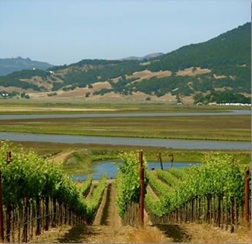The Bleeding Potential of the Petaluma Gap
I sat and had lunch today in the middle of a region of Sonoma that MUST obtain its own AVA status.
 The Petaluma Gap is, I think, everything and more that the Alcohol and Tobacco Tax and Trade Bureau (TTB) demands of an American Viticultural Area. For the record, the TTB demands that applicants for AVA status show that their region 1) locally known by the name specified, 2) that the boundaries of the proposed AVA have current or historical evidence demonstrating their validity and 3) that there be evidence of growing conditions such as climate, soil, elevation and physical features that distinguish the region.
The Petaluma Gap is, I think, everything and more that the Alcohol and Tobacco Tax and Trade Bureau (TTB) demands of an American Viticultural Area. For the record, the TTB demands that applicants for AVA status show that their region 1) locally known by the name specified, 2) that the boundaries of the proposed AVA have current or historical evidence demonstrating their validity and 3) that there be evidence of growing conditions such as climate, soil, elevation and physical features that distinguish the region.
This defines the "Petaluma Gap".
Currently the Petaluma Gap region sits primarily within that monstrosity of an AVA known as "Sonoma Coast". While the Sonoma Coast has gained some fame among aficionados for its Pinots, the appellation is so large as to be meaningless. Carving it up, starting with the Petaluma Gap region would go a long way toward fixing the problem that is "Sonoma Coast".
The region is located in southern Sonoma and runs on a rough west to southeast direction from the coast to the Sonoma Mountains with the Marin County border to the south and the northern edge running up to Santa Rosa.
As is written on the Petaluma Gap Winegrowers Alliance's website, "Wind and fog define the area, giving the term "micro-climate" real meaning."
And there is no question this is true. Most of the region is well below the fog line and is covered in fog in the morning and the night, unlike much of Sonoma Coast that is above the fog line. This is Pinot, Chard and Syrah Country. And there is even some riesling planted that I can't wait to try.
 I was sitting on the veranda of a beautiful estate, Azari, that has yet to release its first wine. When it does, wine folks will flock to it. But for now, the wines are still in barrel and we sat above them eating a quiet lunch, the owners and I. We talked wine, history, the industry and about our pasts and looked out at what are already golden hills.
I was sitting on the veranda of a beautiful estate, Azari, that has yet to release its first wine. When it does, wine folks will flock to it. But for now, the wines are still in barrel and we sat above them eating a quiet lunch, the owners and I. We talked wine, history, the industry and about our pasts and looked out at what are already golden hills.
The growers in the Petaluma Gap region primarily sell their wines to top wineries that put "Sonoma Coast" on their labels for lack of a better, more defining term. I'm not sure how the members of the Petaluma Gap Association feel about seeking AVA status. But I know that if they did it would be good for the whole American Viticultural Area program since the uniqueness of this area would demonstrate that the TTB can grant AVA status to a meaningful and deserving region.
It is very easy to become jaded about terroir, appellations, new wineries and even the magnificent landscapes that define Sonoma County after working in the wine industry for 20 some odd years. But then you are find yourself amongst fine people, eating fine and authentic homemade food on a lovely day, in a beautiful region that bleeds potential all while sitting above a collection of barreled wine that demonstrates that potential and the cynicism melts away.

Fitting in the Petaluma Gap, under the bioregion, “Sonoma Coast,” is akin to claiming wetlands are the same as beaches.
There are more than a few members of the Petaluma Gap who are opposed to forming an AVA for the region, but with increasing attention from fine writers like yourself, Tom, there will be a gradual recognition process for Petaluma Gap wines and it might not be such an extreme concept after all. As a backyard grape grower and hobby winemaker member of the Petaluma Gap and a good friend of the Azari’s, I’m delighted to hear that you’ve discovered our charms as a largely undiscovered, though thoroughly authentic little wine region.
Francis,
I just don’t see the downside of petitioning for AVA status. If winemakers want to use the “Sonoma Coast” appellation instead of the “Petaluma Gap” appellation it’s perfectly legal to do so. It’s a win win.
I see the point of your argument. I like the idea of identifying grapes originating from the Petaluma Gap or any unique region. However, I would be reluctant to assign any new appellations because of what I would call the dilution factor. Look at Sonoma County in general, Green Valley, Bennett Valley, even Chalk hill. They are just too small and unknowable. The wines become exclusive on one end and sub par on the other, both being overpriced. A handful of growers and wineries reap the benefits without over all benefit for the Sonoma county wine industry. The idea of making appellations more detailed is more akin to gerrymandering then progress.
The idea of making appellations more detailed is akin to being more honest. The other issue is what’s so important about promoting Sonoma County, in general. Producers who make wine from Petaluma Gap-grown grapes can put “Petaluma Gap”, “Sonoma Coast”, “North Coast”, ‘Sonoma County” or even “California on their label if they choose.
“Bennett Valley”, “Chalk Hill” and “Green Valley” are only unknowable if we choose to ignore their unique characteristics.
Tom, I tend to agree. There seems to be something unique about that area. I would just urge the PG people to take their time and commission really solid studies, to avoid the hassles we just saw down in Paso Robles with that Westside thing.
AVAs that have true significance are ultimately a boon to wine drinkers. The argument that only the wineries benefit is very odd. Wine is only worth what consumers will pay for it. The Chalk Hill AVA does not have a vast array of grapes so we tend to associate it with one winery, and that winery does charge top dollar fo its wines. But the owners of that winery charge those prices first because they make great efforts to make great wines and secondly because they not only believe the wines are worth the prices but also because they can get those prices. And they would charge big prices no matter what geographic designation was on the label.
The issue of price in this situation is truly hard to fathom. The Sonoma Coast and Russian River AVAs are so broad that they have questionable meanings. Yet, there are expensive wines under those AVAs, and creating smaller and meaningful AVAs like Petaluma Gap is not going to change the pricing equation.
I am disappointed, however, that Tom accepted a free lunch because now I have to worry that his advocacy of this new AVA is related to the quality of the lunch served and his need to have someone save him from his own cheese sandwiches.
I’m all for recognition of different geographical and climatic AVA’s…but it’s a bit of a naff name! Here in Napa, the squabble between Tulocay and Coombsville (in the SE section of the valley), led to the partition being thrown out! The name itself seems to be important.
Petition that is!!!!
Tom, I am with you all the way on this idea. If the qualifications are met and there is terroir and resulting fruit that is truly distinct from the surrounding area, I as a consumer would want to know that. It’s often a gamble on what a consumer is going to experience in a bottle from any huge AVA like that. And, as a winegrower/winemaker I would certainly want the recognition of the quality and distinct notariety that comes with it, regardless of price change.
Charles,
Hell, I’d pimp Blue Nun to save myself from my cheese sandwiches!!
Seems there are two issues here: whether Petaluma Gap is worthy of AVA-status, and whether such specific AVAs are useful to consumers. It also seems like we all agree!
Absolutely wonderful–and distinct–wines come out of the Petaluma Gap, but they bear little resemblance to the also wonderful wines of the “true” Sonoma Coast.
I do think most consumers don’t know or care much about AVAs, and to the extent that they know the Napa Valley AVA, many are unclear on what and where it is. But that’s no reason not to be clear, honest, and precise about where a wine comes from.
That said, I think the nesting AVA idea, currently frowned upon by TTB, is helpful to consumers. “Petaluma Gap” may mean little to a consumer, but “Petaluma Gap/Sonoma County” could be helpful.
To Matt:
TTB does not have more than half a leg to stand on. It is the agency, and its direct precessor called ATF (same folks, by the way) that created the zoo of meaningless AVAs in the first place. Sonoma Coast is a joke. Russian River Valley has been so polluted by extensions that it now threatens to become a joke as folks in the eastern hills like Chalk Hill and environs rush to plant Pinot Noir because they can call it Russian River Valley. We all know how utterly excessive is the Napa Valley AVA.
So, when legitimately separate areas like Petaluma Gap come forward, they need to be recognized, not discouraged. I know we are not in disagreement on that point but we do need to unite to get legitimate AVAs recognized as a first step. At some point, maybe, if the wineries do not gang up on us, we can then somehow fix the ugly gerrymandered AVA boundaries that are so misleading.
Tom–
Here is the lunch problem. Apparently, under the newly emerging standards of conduct for bloggers, it is OK to accept a bad cheese sandwich and not be accused of conflict of interest. But, heaven help you if you actually enjoy the lunch. Now you are as “suspect” as that nasty Robert guy.
By the same token, it will be OK to accept samples of Two Buck Chuck but not samples of Six Buck Sauvignon Blanc.
Amen brother!